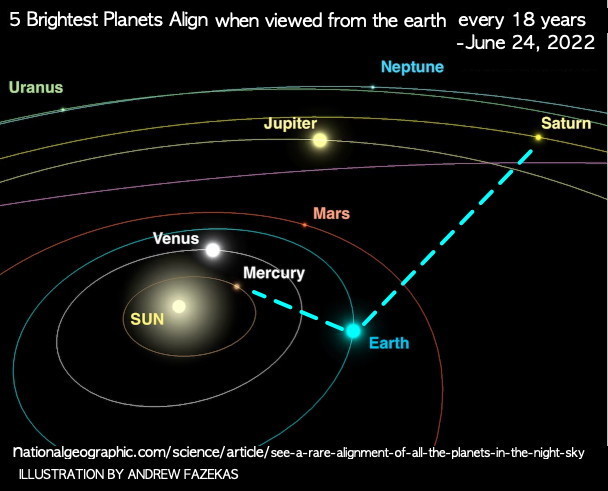 Science
Science
 Astronomy
Astronomy
 Solar System
Solar System

Don's Home
 Science
Science
 Astronomy
Astronomy
 Solar System
Solar System

| Contact |
 When viewed from the earth the planets appear in a line across the pre-dawn horizon. Click image for more. Fazekas does a good job of showing the relative brightness of the planets. Venus is much brighter than Mars even though in this configuration they are about the same distance from the earth because it is blanketed by highly reflective clouds. Jupiter is bright because it is the largest planet.
1. AU - Astronomical Unit - Average distance from earth to sun = 92.96 Million (M) mi = 149.60 M km
2. Time to rotate around the sun is in earth days and years.
3. Planet colors: You will see images of venus that are a violate color (taken in ultra-violet by the hubble telescope), and orange (what it looks like under the clouds). But it appears white (the cloudtops is all you see) in normal light. Venus is the brightest object in the sky except for the Sun and Moon. See Venus at the BBC. Many photos of Jupiter show more vibrant coloring with deeper reds and yellows, but these were created using filters to reveal more detail in the cloud structure. The colors we see are created by gases and clouds in the upper layers of the atmosphere. The primary colors in Jupiter's atmosphere are orange and white. The white bands are created by clouds of ammonia while the orange regions are ammonium hydrosulfide clouds. Sulfur in the upper atmosphere of saturn, gives it an overall yellowish hue. Small amounts of methane gas in uranus' and neptune's atmospheric clouds give them a light blue color. Neptune appears somewhat darker because it receives less light from the Sun. See Planet colors. 4. When Pluto was downgraded to a dwarf planet it was suggested that it's moon Charon also be consedered a dwarf planet. 5. I can't remember where I saw this symbol for sedna, and haven't been able to find it again, so it may not be correct.
Sedna was discovered on Nov. 15, 2003. There was originally disagreement as to whether Pluto or Sedna should be classified as planets, since there are other small (less than 2,000 mi in diameter - smaller than earth's moon) objects orbiting the sun beyond the orbit of pluto.
Sedna is not much larger than the Asteroid, Ceres (Diameter 600 miles), in the asteroid belt. Sedna's orbit is extremely eccentric ranging from 76-850 AUs. It is currently 86 AU from the sun, in the constellation Cetus, just 12 degrees south of the ecliptic, next to the zodiacal constellation of Aries. Sedna is getting closer to the sun and will reach its closest point (perihelion) in 2075-76. The discoverers of Sedna describe it as an inner Oort Cloud object, because it never enters the Kuiper Belt. Sedna is currently 8 billion miles away but is getting closer to the sun because of it's elliptical orbit and will reach its closest point (perihelion) in 2075-76. More information on sedna at CalTech. There are other planetoids in our solar system. See the asteroid page for more. * Named moons - Number of moons named by the International Astronomical Union (IAU) as of 2005. Jupiter, Saturn, Uranus and Neptune have additional unnamed moons. See: Moons and Planets at NASA, Moons of the Solar System at the Planetary Society. and Table of Planets at the University Corporation for Atmospheric Research (UCAR). In addition to Saturn, jupiter, uranus and neptune all have small ringsring systems. All the planets rotate in the same direction as their orbits (counter clockwise when looking from the north) except Venus, Uranus and Pluto. Venus rotates clockwise when viewed from the north the sun rises in the west. Uranus' and pluto's axis are almost parallel to the ecliptic (i.e. tilted 90°). The terrestrial planets are the four innermost planets in the solar system, Mercury, Venus, Earth and Mars. They are called terrestrial because they have a compact, rocky surface like the Earth's. The planets, Venus, Earth, and Mars have significant atmospheres while Mercury has almost none. Below is a close-up picture of the four terrestrial planets Jupiter, Saturn, Uranus, and Neptune are known as the Jovian (Jupiter-like) planets , because they are all gigantic compared with Earth, and they have a gaseous nature like Jupiter's. The Jovian planets are also referred to as the gas giants, although some or all of them might have small solid cores.
| |||||||||||||||||||||||||||||||||||||||||||||||||||||||||||||||||||||||||||||||||||||||||||||||||||||||||||||||||||||||||||||||||||||||||||||||||||||||||||||||||||||||||
|
Links: Return toAstronomy
| |||||||||||||||||||||||||||||||||||||||||||||||||||||||||||||||||||||||||||||||||||||||||||||||||||||||||||||||||||||||||||||||||||||||||||||||||||||||||||||||||||||||||